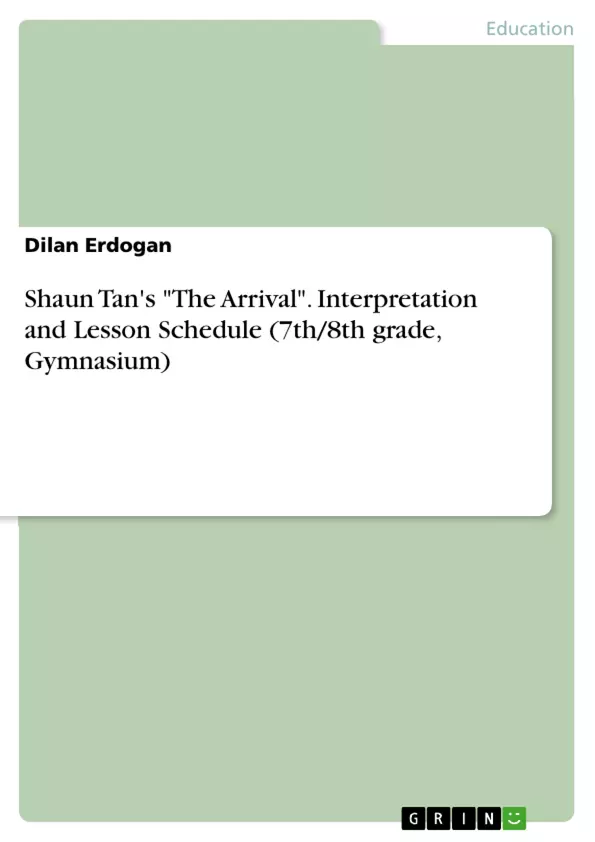This text contains an essay and the schedule for an English lesson (seventh/eighth grade Gymnasium). The author shows how to introduce the graphic novel "The Arrival" by Shaun Tan. This book starts with an essay discussing and interpreting the novel. After this, the author describes how the novel could be dealt with by teachers.
This work focuses on one specific graphic novel of Tan. Hence, the term "graphic novel" will be used frequently, thus a definition needs to be given. Until the 1970s, comics were seen as books for young children and youths without any cognitive or literary demands. In 1978, Eisner and Steranko published comic books and called them graphic novel in order to prove that comics too are demanding. In the 1980s, Art Spiegelmann published his controversial graphic novel "Maus I", which deals with his families experience in the Holocaust. Spiegelmanns graphic novel not only supported Eisner and Steranko's efforts, it even managed to enter classrooms as an example of serious literature.
According to Monnin, graphic novels are the perfect mix of print-text and image literacy, which makes it easy to have literature suitable for a larger group of students. Since some students are rather verbal-linguistic and others rather visual learners, a graphic novel seems to be a nice arrangement which fits both. This option makes it possible to get more students interested in literature and motivates them to read and to participate in the course. Furthermore, Monnin highlights the importance of this change for teachers. Teachers have the opportunity to change the conservative print-text literature school courses into innovative and more creative courses, therewith showing a different feature of literature to the wider society.
Table of Contents
- Argumentative Essay
- Lesson Sequence
- First Lesson
- Reflection
- Appendix
- References
Objectives and Key Themes
This work examines the graphic novel "The Arrival" by Shaun Tan, exploring its potential as a valuable tool for English language teaching. The author analyzes the graphic novel's effectiveness in engaging students, promoting critical thinking, and fostering a deeper understanding of visual and textual communication.
- The evolution of graphic novels as a literary form and their increasing relevance in contemporary culture.
- The pedagogical benefits of using graphic novels in the classroom, particularly for engaging reluctant readers and developing critical thinking skills.
- The importance of multimodal literacy and the role of images in enhancing comprehension and promoting diverse learning styles.
- The significance of student interpretation and the development of democratic classroom environments.
- The application of transactional theory and reader response in the context of graphic novel pedagogy.
Chapter Summaries
- Argumentative Essay: This chapter delves into the background of Shaun Tan, the author of "The Arrival," and discusses the increasing popularity and acceptance of graphic novels as a literary genre. It also examines the evolution of graphic novels from their early days as children's entertainment to their current status as a form of serious literature capable of engaging a wider audience.
- Lesson Sequence: This chapter outlines a planned lesson sequence for using "The Arrival" in the classroom, outlining the specific activities and objectives for each lesson. It focuses on fostering critical thinking, promoting student engagement, and developing multimodal literacy skills.
- First Lesson: This chapter provides a detailed description of the first lesson in the proposed sequence, focusing on introducing the graphic novel, its context, and engaging students in an initial exploration of the text and images.
- Reflection: This chapter reflects upon the effectiveness of the implemented lesson sequence, analyzing student engagement, comprehension, and the overall success of using "The Arrival" as a teaching tool.
Keywords
This work focuses on the use of graphic novels in English language teaching, particularly exploring the potential of Shaun Tan's "The Arrival." Key themes include multimodal literacy, critical thinking, student engagement, reader response, and transactional theory.
- Quote paper
- Dilan Erdogan (Author), 2018, Shaun Tan's "The Arrival". Interpretation and Lesson Schedule (7th/8th grade, Gymnasium), Munich, GRIN Verlag, https://www.grin.com/document/514938



